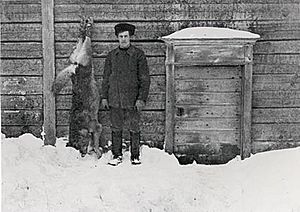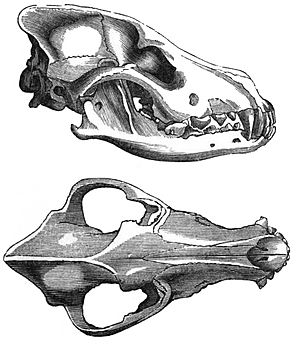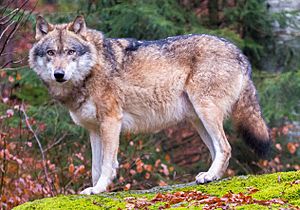Eurasian Wolf facts for kids
The Eurasian Wolf (Canis lupus lupus) is a type of Grey Wolf (Canis lupus). It is also known by many names like the Common Wolf, European Wolf, Carpathian Wolf, Steppes Wolf, Tibetan Wolf, and Chinese Wolf. These wolves originally lived across most of Eurasia, reaching as far south as the Himalayas and the Hindu Kush Range.
Contents
Physical Description
Body Shape and Features
Eurasian wolves have a distinct look compared to wolves from North America. Their heads are narrower and gently taper towards the nose. Their ears are taller and closer together. Also, their legs are longer and their feet are narrower. Their tails have less fur.
In contrast, American wolves often have shorter ears, wider foreheads, and thicker muzzles. This gives them a look that some people compare to a Canadian Eskimo Dog.
Size and Weight
The size of Eurasian wolves can vary depending on where they live. Wolves in Russia and Scandinavia are usually larger and heavier than those in Western Europe. They have been compared to the big wolves found in north-western Montana and Washington in the United States.
Adult wolves in Russia can be about 105 to 160 centimeters (41 to 63 inches) long. They stand about 80 to 85 centimeters (31 to 33 inches) tall at the shoulder. On average, they weigh between 32 to 50 kilograms (71 to 110 pounds). The heaviest recorded wolf was found in Ukraine after World War II, weighing 86 kilograms (190 pounds). Some reports mention even heavier wolves, up to 96 kilograms (212 pounds), but these measurements are not fully confirmed.
Wolves in Sweden and Norway are similar in size to those in central Russia. However, they tend to be more strongly built with deeper shoulders. One wolf in Romania was recorded at 72 kilograms (159 pounds). Italian wolves are typically smaller, with body lengths between 110 to 148 centimeters (43 to 58 inches) and shoulder heights of 50 to 70 centimeters (20 to 28 inches). Male Italian wolves usually weigh 25 to 35 kilograms (55 to 77 pounds), rarely reaching 45 kilograms (99 pounds). The wolves that used to live in Great Britain were similar in size to Arctic wolves.
Where They Live
Historical Decline
The effort to get rid of wolves in Northern Europe began in the Middle Ages. This continued until the late 1800s. In England, laws were made to hunt wolves, and the last one was killed in the early 1500s. Wolves lasted longer in Scotland, hiding in large forests that were later burned down. They survived in areas like Braemar until 1684. In Ireland, the last wolf was thought to be killed in 1786.
In Sweden, a reward for killing wolves was offered in 1647. This happened after wolves started hunting farm animals because their usual prey, like moose and reindeer, had become scarce. The Sami people helped to remove wolves in northern Sweden through organized hunts. By 1960, very few wolves were left in Sweden. The last one was killed in 1966. Wolves were completely gone from Denmark by 1772 and from Norway by 1973.
Finland's wolf population almost disappeared in the 20th century. Even though wolves from Russia sometimes moved into Finland, their numbers were low. By 1900, wolves were only found in eastern and northern Finland. Their numbers increased after World War II. In 2005, there were about 250 wolves in Finland, but by 2013, this number dropped to around 140. However, by early 2016, the population grew again to about 300 to 350 wolves.
In Central Europe, wolf numbers dropped sharply in the early 1800s. This was due to organized hunts and fewer hoofed animals for them to eat. In Bavaria, the last wolf was killed in 1847. By 1899, they had disappeared from the Rhine regions. Wolves also largely vanished from Switzerland before the end of the 1800s. In 1934, Nazi Germany was the first country to protect wolves by law. However, wolves were already gone from Germany at that time. The last wild wolf killed in Germany before 1945 was in 1904. Today, wolves have returned to Germany.
Wolf hunting in France became official under Charlemagne between 800 and 813 AD. He created a special group of wolf hunters called the louveterie. This group was stopped after the French Revolution in 1789 but started again in 1814. In 1883, over 1,300 wolves were killed, many by poison.

In Eastern Europe, wolves were never completely wiped out. This is because the area connects to Asia and has large forests. Still, wolf populations in Eastern Europe became very small by the late 1800s. Wolves disappeared from Upper Hungary in the early 1900s. By the mid-1900s, they were only found in a few forests in eastern Poland.
Wolves in the eastern Balkans benefited from being close to the former Soviet Union. This region has large plains, mountains, and farmlands. In Hungary, wolves were only found in half the country around 1900. They were mostly limited to the Carpathian Basin. Romania kept a large number of wolves. From 1955 to 1965, about 2,800 wolves were killed each year out of a population of 4,600. The lowest point was in 1967, when the population dropped to 1,550 animals.
The killing of wolves in Bulgaria happened more recently. A population of about 1,000 wolves in 1955 was reduced to only 100 to 200 by 1964. In Greece, the species disappeared from the southern Peloponnese in 1930. Even with intense hunting in the 1700s, wolves never completely disappeared from the western Balkans, from Albania to the former Yugoslavia. Organized wolf hunting began in Yugoslavia in 1923. A committee was set up in Kocevje, Slovenia, and it successfully reduced wolf numbers in the Dinaric Alps.
The grey wolf's range in the Soviet Union covered almost the entire country. They were only absent from a few islands. Wolves were wiped out twice in Crimea, once after the Russian Civil War and again after World War II. After these wars, Soviet wolf populations grew very large twice. In the 1940s, 30,000 wolves were hunted each year from a population of 200,000. In peak years, 40,000 to 50,000 were hunted. Soviet wolf populations reached a low point around 1970, disappearing from much of European Russia.
As of 2017, the Grey Wolf is still gone from 8 European countries. These include Austria, Belgium, Denmark, Ireland, Luxembourg, Netherlands, Switzerland, and the United Kingdom.
Current Recovery
European wolf populations started to recover after the 1950s. This happened because old farming and rural ways of life changed. This meant there was less need to hunt wolves so much. By the 1980s, small groups of wolves grew. This was due to fewer people living in rural areas and more wild animals for wolves to hunt.
In 1978, wolves began to return to central Sweden after being gone for twelve years. Since then, they have spread into southern Norway. As of 2005, there are at least 100 wolves in Sweden and Norway, including eleven breeding pairs. The grey wolf is fully protected in Sweden and partly protected in Norway. These Scandinavian wolf populations survive because they are close to Finland's border with the Republic of Karelia, which has many wolves. Wolves in Finland are protected everywhere, and can only be hunted with special permission. A decrease in moose numbers has reduced the wolves' food supply. Since 2011, the Netherlands, Belgium, and Denmark have also reported wolf sightings. These wolves likely migrated from nearby countries. However, they are still considered extinct in these areas.
Wolf populations in Poland have grown to about 800 to 900 animals since 1976, when they were classified as a game species. Poland is very important for wolves to spread into nearby Central European countries. To the east, Polish wolves connect with populations in Lithuania, Belarus, Ukraine, and Slovakia. A group of wolves in western Poland spread into eastern Germany. In 2000, the first wolf pups were born in Germany. In 2012, about 14 wolf packs were living in Germany, mostly in the east. A pack with pups was even seen within 15 miles of Berlin. The grey wolf is protected in Slovakia, but there is an exception for wolves that kill farm animals. A few Slovakian wolves move into the Czech Republic, where they are fully protected. Wolves from Slovakia, Ukraine, and Croatia might spread into Hungary. However, a lack of hiding places makes it hard for a stable wolf population to grow there. Even though wolves have special protection in Hungary, they can be hunted with a permit if they cause problems.
Romania has a large wolf population, with about 2,500 animals. The wolf has been a protected animal in Romania since 1996, but this law is not always enforced. The number of wolves in Albania and Macedonia is largely unknown. These two countries are important for connecting wolf populations from Greece to those in Bosnia and Herzegovina and Croatia. Even though wolves are protected, many are illegally killed in Greece each year, and their future is uncertain. Wolf numbers have decreased in Bosnia and Herzegovina since 1986. The species is fully protected in neighboring Croatia and Slovenia.
Wolf populations across Northern and Central Asia are mostly unknown. However, estimates based on annual hunts suggest there are hundreds of thousands. Since the fall of the Soviet Union, the widespread killing of wolves has stopped. Wolf populations have increased to about 25,000 to 30,000 animals throughout the former Soviet Union. This is an increase of about 150%.
Relationships with Humans
Myths and Legends
Many old stories about wolves in Eurasia before Christianity came from Hittite mythology. Wolves were very important in early Indo-European cultures, sometimes even seen as gods. The Dacians highly respected the wolf. Their name came from the Gaulish word Daoi, meaning "wolf people." They saw the wolf as the ruler of all animals and the only strong power against evil.
The Gauls connected wolves with Belenus, their god of light. His name might have come from the Breton word bleiz, which means 'wolf'. A limping wolf was thought to be one way the Slavic sun god Dažbog appeared. Also, the ancient Greeks linked wolves with their own sun god, Apollo.
Images for kids
-
Comparison German shepherd dog
-
Monument to the shooter of one of the last wolves in Lower Saxony 1872
See also
 In Spanish: Lobo europeo para niños
In Spanish: Lobo europeo para niños











